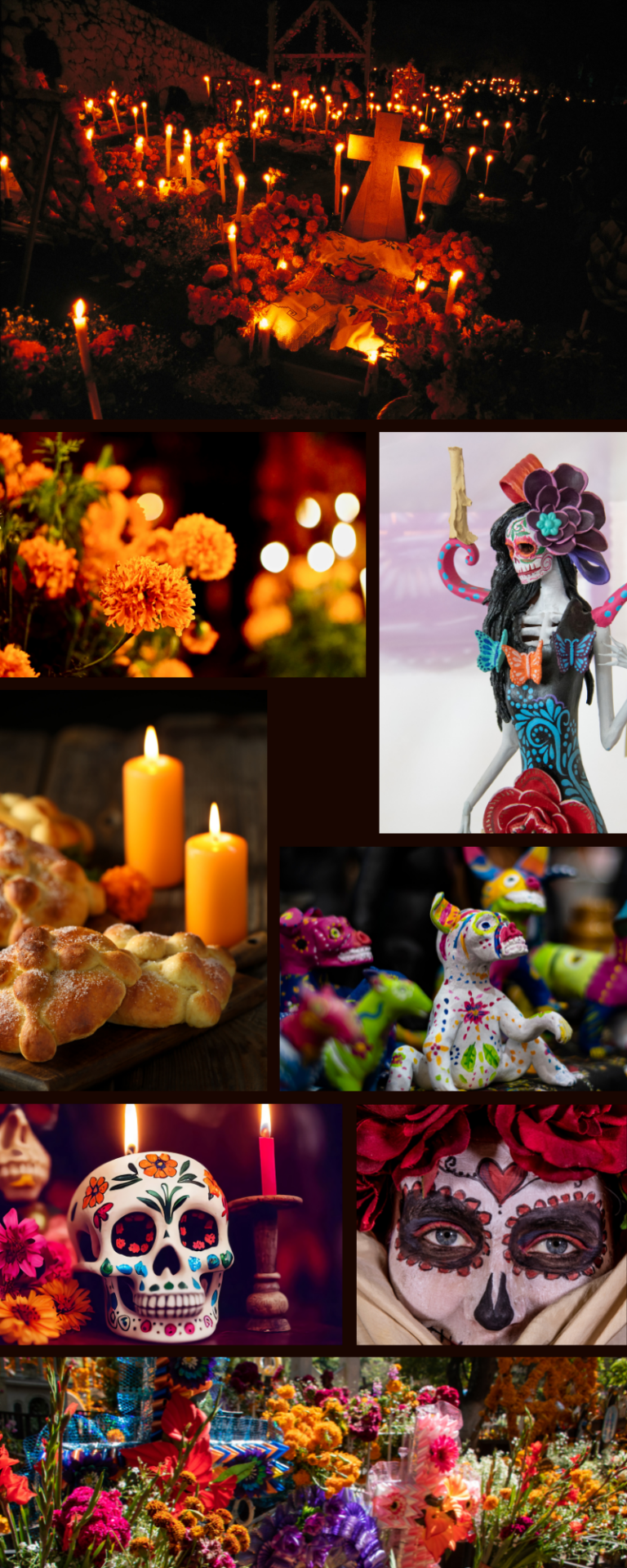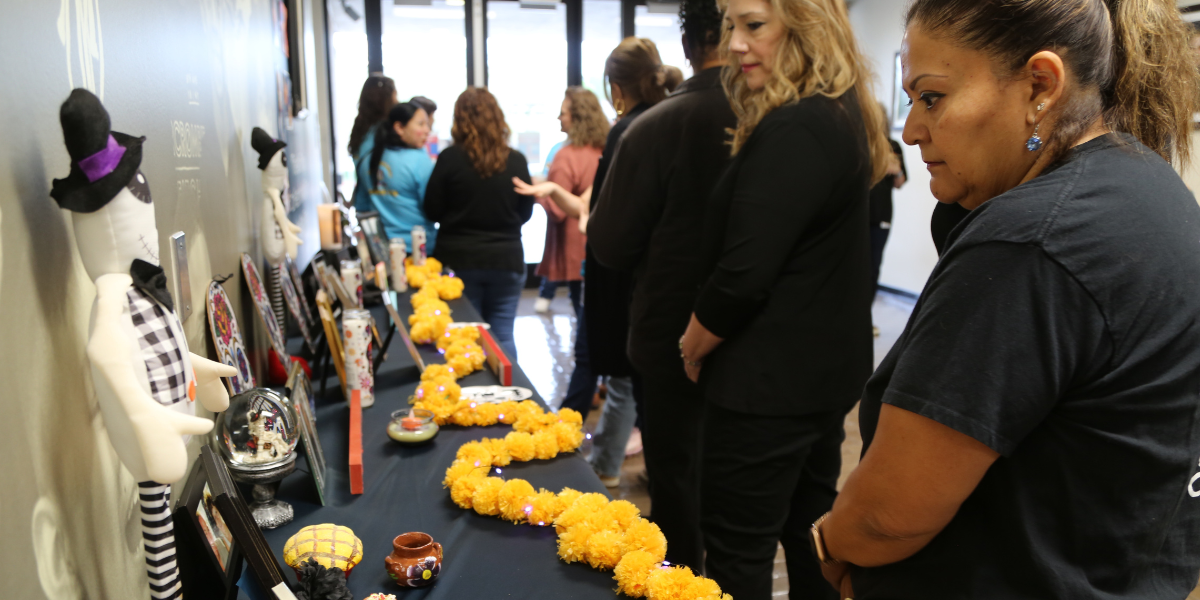
2024-11-02 02:45:03
On November 1, the district’s Donaldson Administrative Building staff celebrated Día de los Muertos (Day of the Dead). This festive social occasion developed from ancient Aztec traditions. It welcomes the return of those who have died and recognizes the cycles of life and death. The holiday was developed mainly in Mexico but is also observed in other places. Día de los Muertos focuses on remembering deceased family members and friends.

Carver High School students Jennifer Ramírez, Cynthia Coronado, and Lauren Jones pose with their and fellow students’ artwork in 2014 at the Lawndale Art Center.
The Family and Community Engagement Department coordinated to create an ofrenda or altar with images of dead family and friends. Traditionally, the ofrenda includes the main elements — earth, wind, water, and fire. The ofrendas also have offerings like the deceased’s favorite foods, beverages, and memorabilia. They also provided Mexican pastries and coffee for the staff to enjoy. Each year, staff who want to participate are encouraged to bring photos to the Family and Community Engagement Office. FACE includes the pictures to create an ofrenda to showcase on November 1.
Origins of Day of the Dead
The idea of celebrating loved ones who have passed comes from the traditions of the native peoples, such as the Aztecs, Mayans, Olmecs, and Toltecs, of what is now Mexico and Central America. Traditions among different groups varied, but all shared the concept of an afterlife. They believed that life and death were part of nature’s cycle.
When Spanish conquistadors arrived in Mexico in the 16th century, they brought their faith, including All Saints Day and All Souls Day celebrations. Day of the Dead, as we know it today, developed from intermingling indigenous and Spanish traditions.
Day of the Dead Today
Today, November 1, is dedicated to honoring the children who have died. It is often called Día de los angelitos or Day of the Little Angels. November 2 is reserved for honoring all who have passed.
Key Words
 Ofrenda — altar; ofrendas light the way home
Ofrenda — altar; ofrendas light the way home- Calaveras — skulls; symbolize death and rebirth
- Calacas — skeletal figurines
- La catrina — a stately female skeleton in a flowered hat and long dress
- Cempasuchil — a type of marigold flower
- Papel picado — colorful, artfully cut pieces of crepe paper
- Pan de muertos — special bread representing the souls of the dead
- Incense (copal) represents the changing of the physical to the spiritual
- Salt and water represent ongoing life
- Candles represent light, faith, and hope
- Fresh flowers, especially marigolds, represent the fleetingness of life
- Monarch butterflies were believed to be the souls of the departed journeying back to the land of the living.
- Alebrijes are brightly colored Mexican folk art sculptures of fantastical (fantasy/mythical) creatures.
- Comparsa is a carnival-like celebration where people dress up in costumes and dance.
- Tapete de arena — In some regions of Mexico, sand sculptures or tapestries (tapetes de arena) are a vital part of the celebration. These are created with sand and pigment and sometimes other elements such as seeds, beans, flower petals, and sawdust. They may depict religious themes, but more often, they playfully represent death.
- Xoloitzcuintli dog—This ancient hairless dog breed (which Frida Kahlo once had as a pet) is associated with Día de los Muertos because the dog breed was known to accompany spirits into the underworld, hence why the dog figurine is placed on altars as a spirit guide.
Families gather to prepare for the holiday several days in advance in Mexico, Central America, South America, and places where the Dia de los Muertos is observed. Preparations first include cleaning the gravesite of loved ones and cleaning the home. They will then prepare their favorite foods, such as pan de muertos or bread of the dead. There is an ofrenda decorated with flowers, photos of deceased family members, and offerings for the dead in many homes. Family members will also decorate and place offerings for the dead at their gravesites. They believe that the spirits of their deceased relatives will visit on the Day of the Dead because the offerings entice them to return. Some families will spend most of the night in the cemetery singing and eating to celebrate the spiritual return of their loved ones.
 Most festivals feature calaveras, which once symbolized death and rebirth to the ancient people. Calaveras are often made of sugar or clay. In towns and cities throughout Mexico, revelers don makeup and costumes to look like calaveras or skeletons in fancy dresses called catrinas and hold parades and parties. In some Día de los Muertos regional celebrations, people wear wooden skull masks called calacas and dance to honor their deceased relatives.
Most festivals feature calaveras, which once symbolized death and rebirth to the ancient people. Calaveras are often made of sugar or clay. In towns and cities throughout Mexico, revelers don makeup and costumes to look like calaveras or skeletons in fancy dresses called catrinas and hold parades and parties. In some Día de los Muertos regional celebrations, people wear wooden skull masks called calacas and dance to honor their deceased relatives.
Día de los Muertos is an explosion of color and life-affirming joy. It is about remembering loved ones — family members and friends — who have passed and demonstrating love and respect for them.
Click on the links below to learn more about Día de los Muertos.
History
Holiday
Smithsonian Institute
Lonely Planet







